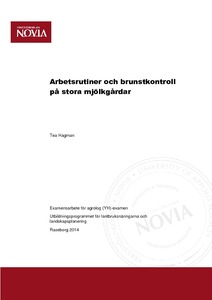Arbetsrutiner och brunstkontroll på stora mjölkgårdar
Hagman, Tea (2014)
Hagman, Tea
Yrkeshögskolan Novia
2014
All rights reserved
Julkaisun pysyvä osoite on
https://urn.fi/URN:NBN:fi:amk-201404305486
https://urn.fi/URN:NBN:fi:amk-201404305486
Tiivistelmä
Sammanfattning
Det här arbetet grundar sig på brunstkontrollen på stora mjölkgårdar samt arbetsrutiner som det varit mycket tal om den senaste tiden inom husdjursproduktionen. Arbetet innehåller litteraturstudier och intervjuer, som gjordes i svenska Österbotten, om arbetsrutiner och brunstkontroll på större mjölkgårdar. Syftet med detta arbete är att hjälpa mjölkföretagen att utveckla skriftliga arbetsrutiner och förbättra brunstkontrollen på gården, samt att förbättra trivseln på gården för alla som arbetar där och göra det enklare att utbilda nya arbetare eller avbytare. Det som kom fram i intervjuerna var att brunstkontrollen i de flesta fall är lite bristfällig och arbetsrutiner hade inte så stor vikt i företagen.
I arbetet beskrivs hur kons könsorgan fungerar och alla hormoner som inverkar på brunstcykeln. Brunsttecknen som kon visar är detaljerat beskrivna för att lättare kunna förstå sig på och avgöra när kon är brunstig samt för att pricka in rätt inseminationstidpunkt. Hjälpmedel som kan vara till stor hjälp för att förbättra brunstkontrollen finns uppräknade i arbetet. Fertilitetstörningar och behandlingar av dem tas också upp för att hjälpa mjölkproducenten att förstå sina kors brunstbeteenden. Även kalvningsintervall samt när i laktationen man gör första insemineringen diskuteras. Summary
This thesis deals with the estrus control on big dairy farms and working routines, which has recently been a big topic of conversation in animal husbandry. The thesis includes literature studies and interviews with Swedish-speaking dairy farmers in Ostrobothnia about working routines and estrus control. The results of the interviews were that estrus control is very poor and the working routines were not considered important at the time. The aim for this thesis is to help dairy farms to develop written working routines and to improve estrus control on the farm, to create a better working environment.
The thesis provides a description of how the cow’s reproduction organ works and the hormones’ impact on the estrus cycle. The estrus signs of the cattle are described in detail in order to help the farmer understand and decide when the cow is in estrus and when to inseminate her. Estrus detection aids for improving the estrus control are also described. Fertility problems and their treatment are included in the thesis to help the farmer understand the cattle’s estrus behavior. Calving intervals and the time of insemination during the cow’s lactation is also discussed.
Det här arbetet grundar sig på brunstkontrollen på stora mjölkgårdar samt arbetsrutiner som det varit mycket tal om den senaste tiden inom husdjursproduktionen. Arbetet innehåller litteraturstudier och intervjuer, som gjordes i svenska Österbotten, om arbetsrutiner och brunstkontroll på större mjölkgårdar. Syftet med detta arbete är att hjälpa mjölkföretagen att utveckla skriftliga arbetsrutiner och förbättra brunstkontrollen på gården, samt att förbättra trivseln på gården för alla som arbetar där och göra det enklare att utbilda nya arbetare eller avbytare. Det som kom fram i intervjuerna var att brunstkontrollen i de flesta fall är lite bristfällig och arbetsrutiner hade inte så stor vikt i företagen.
I arbetet beskrivs hur kons könsorgan fungerar och alla hormoner som inverkar på brunstcykeln. Brunsttecknen som kon visar är detaljerat beskrivna för att lättare kunna förstå sig på och avgöra när kon är brunstig samt för att pricka in rätt inseminationstidpunkt. Hjälpmedel som kan vara till stor hjälp för att förbättra brunstkontrollen finns uppräknade i arbetet. Fertilitetstörningar och behandlingar av dem tas också upp för att hjälpa mjölkproducenten att förstå sina kors brunstbeteenden. Även kalvningsintervall samt när i laktationen man gör första insemineringen diskuteras.
This thesis deals with the estrus control on big dairy farms and working routines, which has recently been a big topic of conversation in animal husbandry. The thesis includes literature studies and interviews with Swedish-speaking dairy farmers in Ostrobothnia about working routines and estrus control. The results of the interviews were that estrus control is very poor and the working routines were not considered important at the time. The aim for this thesis is to help dairy farms to develop written working routines and to improve estrus control on the farm, to create a better working environment.
The thesis provides a description of how the cow’s reproduction organ works and the hormones’ impact on the estrus cycle. The estrus signs of the cattle are described in detail in order to help the farmer understand and decide when the cow is in estrus and when to inseminate her. Estrus detection aids for improving the estrus control are also described. Fertility problems and their treatment are included in the thesis to help the farmer understand the cattle’s estrus behavior. Calving intervals and the time of insemination during the cow’s lactation is also discussed.
